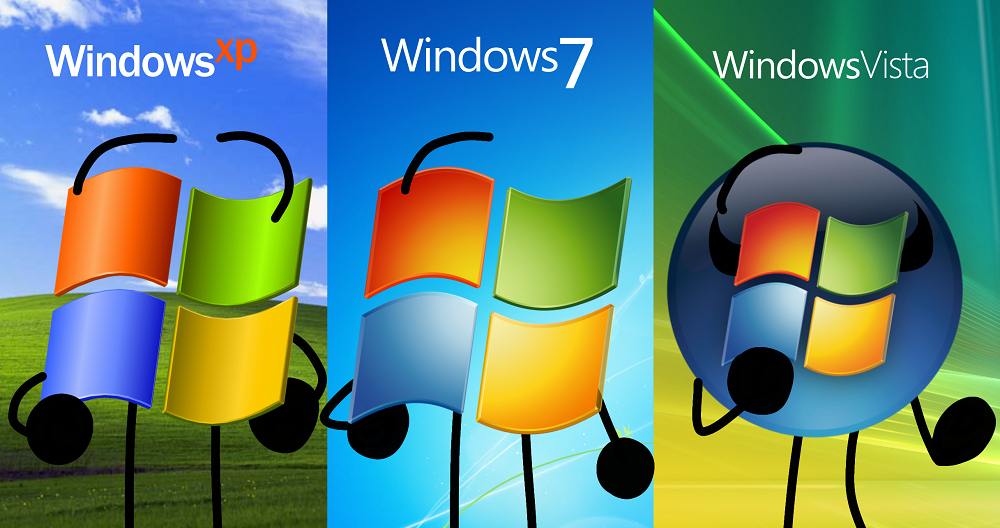Windows Evolution: Unraveling the Distinctions Between Windows 7, Vista, and XP

Introduction:
The landscape of Microsoft’s operating systems has undergone a transformative journey, with Windows 7, Vista, and XP each leaving an indelible mark on the digital era. This extensive exploration dissects the nuances that differentiate these Windows iterations, shedding light on the evolution of features, user interfaces, and underlying technologies that defined each era in computing.
1. User Interface Evolution:
Windows XP’s Familiarity: Windows XP, introduced in 2001, was characterized by its iconic Start menu, taskbar, and simple desktop layout. The “Luna” visual style was synonymous with XP, offering a clean and familiar interface that resonated with users.
Vista’s Aesthetic Overhaul: Windows Vista, released in 2007, embarked on a significant aesthetic overhaul. The Aero Glass theme introduced transparent elements, sophisticated window animations, and revamped Start menu navigation. While visually striking, these changes required more robust hardware, leading to varied user experiences based on system specifications.
Windows 7’s Refined Simplicity: Windows 7, unveiled in 2009, struck a balance between the familiarity of XP and the visual sophistication of Vista. The taskbar underwent a notable redesign, introducing features like Jump Lists for quick access to recent files. The Aero theme persisted, albeit with refinements that optimized performance.
2. Performance and System Requirements:
XP’s Lightweight Efficiency: Windows XP earned a reputation for its efficiency and relatively modest system requirements. It thrived on a broad range of hardware, making it accessible to a diverse user base. Its lightweight nature contributed to its enduring popularity even as newer versions emerged.
Vista’s Hardware Intensity: Windows Vista, in its pursuit of visual excellence, placed higher demands on hardware. The Aero Glass effects and other enhancements strained systems with limited resources, leading to performance issues on some machines. This resulted in a mixed reception among users.
Windows 7’s Optimization: Learning from the lessons of Vista, Windows 7 prioritized performance optimization. The operating system maintained a sleek visual interface without sacrificing efficiency. This strategic balance contributed to Windows 7’s widespread adoption across a spectrum of devices.
3. Security Enhancements:
XP’s Security Challenges: Windows XP, while beloved, faced security challenges as cyber threats evolved. Over time, its vulnerabilities became apparent, prompting Microsoft to issue numerous security updates to address emerging risks.
Vista’s Security Measures: Windows Vista implemented enhanced security features, including User Account Control (UAC) to mitigate unauthorized system changes. While UAC aimed to bolster security, it faced criticism for its intrusive prompts and user experience impact.
Windows 7’s Comprehensive Security: Windows 7 built on Vista’s security foundation, refining UAC and introducing additional measures like BitLocker encryption. The operating system prioritized a balance between robust security and a user-friendly experience.
4. Compatibility and Driver Support:
XP’s Enduring Compatibility: Windows XP, with its long tenure, enjoyed extensive compatibility with a vast array of software and hardware. Its longevity, however, posed challenges as technology advanced, and newer peripherals and applications demanded modern platforms.
Vista’s Transition Period: Windows Vista’s launch triggered a transition period where hardware manufacturers and software developers adapted to the new architecture. Initially, this led to compatibility issues, but as the ecosystem adjusted, Vista became more compatible over time.
Windows 7’s Streamlined Compatibility: Windows 7 capitalized on the lessons learned from Vista’s early challenges. Microsoft worked closely with industry partners to ensure broad hardware and software compatibility, facilitating a smoother transition for users.
5. System Stability and Reliability:
XP’s Stability Legacy: Windows XP earned a reputation for stability, becoming a dependable workhorse for millions. Its straightforward architecture contributed to a reliable computing experience.
Vista’s Initial Stability Concerns: Windows Vista faced criticism for stability issues in its early days. The resource-intensive Aero effects and compatibility challenges contributed to a perception of diminished reliability.
Windows 7’s Stability Triumph: Windows 7 emerged as a stability triumph, combining the reliability of XP with the visual enhancements of Vista. The operating system prioritized system stability, reducing crashes and enhancing the overall user experience.
6. Search Functionality and User Productivity:
XP’s Basic Search: Windows XP featured a basic file search functionality. While functional, users often had to navigate through multiple folders to locate specific files.
Vista’s Enhanced Search: Windows Vista introduced an improved search function that allowed users to search for files and programs directly from the Start menu. The enhanced search functionality streamlined the user experience.
Windows 7’s Advanced Search and Libraries: Windows 7 elevated search functionality with Libraries, a feature that aggregated content from various locations. The operating system made it easier for users to organize and find files, contributing to heightened productivity.
7. Windows Explorer Improvements:
XP’s Functional Explorer: Windows XP’s Windows Explorer provided basic file management capabilities. However, as users accumulated more digital content, the need for enhanced organizational features became apparent.
Vista’s Navigation Pane and Preview Pane: Windows Vista introduced the Navigation Pane and Preview Pane in Windows Explorer, allowing users to navigate folders more efficiently and preview content without opening files. These additions aimed to improve overall usability.
Windows 7’s Jump Lists and Libraries Integration: Windows 7’s Windows Explorer introduced Jump Lists for quick access to recent files and folders. The integration of Libraries provided a consolidated view of content, further streamlining file management.
Conclusion:
The evolution from Windows XP to Windows 7 marked a captivating journey through the annals of operating system development. Each iteration, whether XP’s simplicity, Vista’s visual prowess, or Windows 7’s harmonious balance, contributed unique elements to the Windows legacy. While XP laid the foundation, Vista experimented, and Windows 7 perfected, collectively shaping the user experiences of millions. Understanding the distinctions between these operating systems not only offers a nostalgic reflection on computing history but also provides insights into the iterative process that defines the Windows ecosystem.




